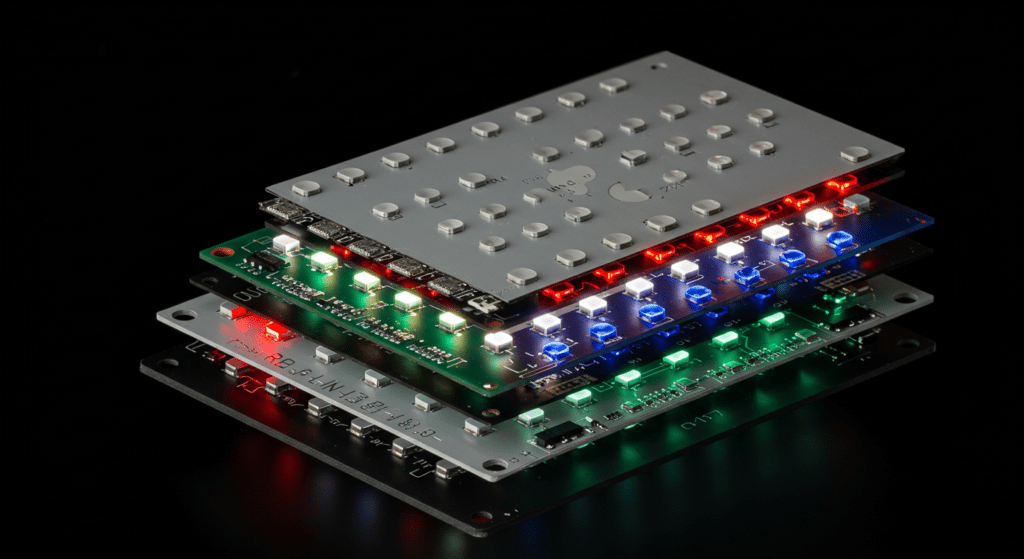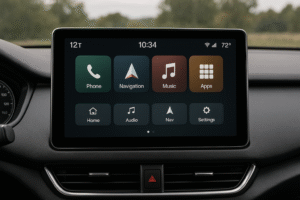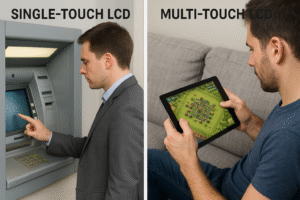
RGBW backlight is an advanced LCD lighting technology that adds a white subpixel to the traditional RGB system, enhancing brightness and energy efficiency.
RGBW integrates red, green, blue, and white LEDs into LCD panels, producing brighter whites without relying on color mixing. This improves light transmission by 20–30%, making it ideal for LED-backlit displays like TVs, smartphones, and monitors. The white subpixel also reduces power consumption, extending battery life in portable devices.
Compared to RGB-only systems, RGBW delivers a broader color spectrum and higher color accuracy, but may slightly lower pixel density in smaller screens. This balance of brightness and efficiency makes RGBW essential for modern LCD backlight displays.
What is RGBW Backlight?

RGBW backlight is an LCD backlight technology that integrates an additional white (W) subpixel into the traditional red (R), green (G), and blue (B) subpixels, forming part of the LED LCD backlight system.
Compared to traditional RGB-only LED backlights, RGBW backlight significantly enhances screen brightness and energy efficiency by utilizing the white subpixel. Traditional RGB backlights rely solely on the combination of red, green, and blue to produce light, whereas RGBW allows more light to pass through using the white subpixel, reducing energy loss.
This technology is widely applied in LCD panels and backlit display devices with LED backlighting. It enhances LCD illumination performance, particularly excelling in scenarios requiring high brightness and energy efficiency, such as small LCD displays.
How Does RGBW Backlight Work?
In LED-backlit LCD displays, the backlight system emits light through LED sources, which then passes through the RGBW subpixel layer. The key role of the white subpixel is to increase light output without additional power consumption.
This design improves contrast in backlit LCDs while reducing energy consumption. For instance, in small LCD display devices, RGBW backlighting enables a brighter screen while extending battery life. Industry data shows that the white subpixel can enhance light transmittance by approximately 50%.
What Are the Advantages of RGBW Backlight?
- Brightness: Significantly enhances the brightness of backlit screens, making it ideal for LCD backlight displays, especially in bright environments.
- Energy Efficiency: Reduces power consumption in LED backlit display devices. Tests indicate that power savings can reach up to 30%, which is particularly beneficial for portable devices.
- Color Performance: Improves white balance and enhances overall vibrancy in LCD displays.
What Are the Disadvantages of RGBW Backlight?
- Resolution Trade-off: The inclusion of a white subpixel may lower the pixel density of small LCDs, potentially reducing image sharpness by about 25%.
- Color Accuracy: Compared to pure RGB systems, RGBW screens may exhibit a 5-10% deviation in color accuracy, which can impact tasks that require precise color reproduction, such as image editing.
What Are the Applications of RGBW Backlight?

RGBW backlight technology is widely used in devices like smartphones, tablets, TVs, and LCD backlight monitors to enhance brightness and energy efficiency.
This technology improves screen backlight performance by integrating white LEDs alongside RGB LEDs, enabling brighter displays and reducing power consumption. It is particularly effective in small LCD displays and portable devices, where energy efficiency is crucial.
- RGBW backlights reduce power consumption by up to 25%, making them ideal for mobile devices.
- Enhanced brightness improves visibility in sunlight for LCD display LED backlights.
- Devices like high-end TVs and LCD backlight monitors leverage RGBW for better color accuracy and contrast.
Examples of Devices Using RGBW Backlight
RGBW technology is featured in advanced TVs, smartphones, and automotive displays for improved brightness and color fidelity.
High-end TVs use RGBW to achieve HDR brightness levels, while automotive displays rely on its wide color gamut for critical information clarity. Smartphones benefit from its energy efficiency, extending battery life during high-brightness usage.
- TVs with RGBW backlights achieve peak brightness of 1200 nits, enhancing HDR performance.
- Automotive displays improve readability in varying light conditions using RGBW LED lighting systems.
- Smartphones equipped with RGBW extend battery life by reducing LED power draw during display operation.
How Does RGBW Compare to Other Backlight Technologies?
RGBW backlights differ from RGB and OLED technologies by offering enhanced brightness and energy efficiency, while RGB focuses on color accuracy and OLED excels in contrast.
RGBW adds a white subpixel to improve brightness and reduce power consumption in LED-backlit displays, making it ideal for portable devices. In contrast, RGB-only systems focus on precise color rendering, while OLED uses self-emissive pixels for superior contrast ratios without requiring a backlight.
- RGBW improves brightness by 20% compared to RGB systems, while consuming 25% less power.
- OLED achieves infinite contrast ratios but is limited by brightness levels of 1000–1500 nits, whereas RGBW can reach 1200 nits.
- RGB systems maintain higher pixel density, benefiting applications like small LCD displays.
RGBW vs. RGB Backlight
RGBW adds a white subpixel to LCD LED light systems, increasing brightness but potentially lowering resolution compared to RGB-only backlights.
The white subpixel in RGBW enhances light transmission and reduces power consumption, but it may compromise pixel density in small LCDs, affecting sharpness. RGB systems retain higher resolution for detailed imagery.
- RGBW produces brighter whites with fewer LEDs, reducing energy use by 15–25%.
- RGB-only systems achieve better pixel density, ideal for applications requiring high-definition displays like LCD backlight monitors.
RGBW vs. OLED
While RGBW excels in brightness and cost-effectiveness for LED LCD backlights, OLED leads in contrast and color depth due to its self-emissive pixels.
OLED panels eliminate the need for a backlight, offering infinite contrast ratios and vibrant colors. However, they are less bright than RGBW systems and more expensive to produce.
- OLED achieves superior black levels by turning off individual pixels, while RGBW relies on local dimming zones for contrast control.
- OLED panels operate at peak brightness of 1500 nits, whereas RGBW can reach up to 1200 nits with improved energy efficiency.
Related Articles:
How does viewing angle relate to LCD backlight design?
What is Backlight Bleed and How Can You Fix It?
How Does PWM Control Backlight Brightness in Modern Displays?
How do different backlight technologies affect color temperature control?
Does Increasing Brightness on OLED Make It Look Whiter on TV?
FAQ
Does RGBW backlight reduce energy consumption in LCD screens?
Yes, RGBW backlights consume 15–25% less power compared to RGB-only systems by using a white subpixel for enhanced brightness without additional energy use.
Can RGBW backlight affect the resolution of small LCD displays?
Yes, adding a white subpixel may lower pixel density in small LCD displays, which can slightly reduce image sharpness.
Is RGBW backlight better than OLED for color accuracy?
No, OLED offers superior color depth and contrast due to its self-emissive pixels, while RGBW focuses on brightness and energy efficiency.
What types of devices commonly use RGBW backlight technology?
RGBW is widely used in TVs, smartphones, tablets, and LCD backlight monitors, especially for portable devices requiring high brightness and low power consumption.
How does RGBW improve visibility in bright environments?
The white subpixel increases light output, making displays with RGBW backlights easier to view under direct sunlight or high ambient light conditions.





